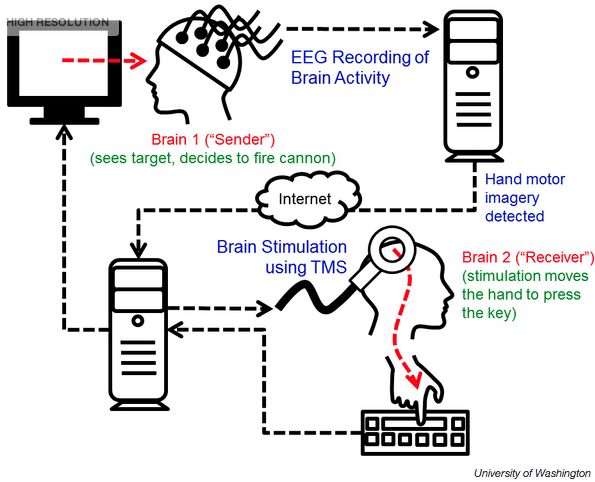There’s no cheer like the cheer of a successful research team going where no man has gone before. On August 12th, 2013, researchers in the computer science lab were understandably excited when they successfully transferred the thoughts of one researcher into the body of another researcher, in another building.

Just how did they pull off this feat? The picture at the right helps understand the setup, and the unique magnetic coil experiment used in their study.
The two researchers in this telepathy-like test were Rajesh Rao and Andrea Stocco. In the experiment, Rajesh wears the electroencephalography (EEG) cap, and Stocco sits in a chair with a magnetic coil place above his cranium. The purpose of the EEG cap is rather obvious – to detect the activity of Rajesh’s brain, and transmit it to a computer. The purpose of the magnetic coil is less obvious – to stimulate a particular brain area. In this case, the magnetic coil was placed directly above Stocco’s motor cortex.
Of course, an EEG cap on one man and a magnetic coil above another man doesn’t imply any communication between the two. That connection (in this case between two buildings on the University of Washington’s campus) was facilitated via the internet – carrying specific information from the motor area of one brain directly to the motor cortex of another brain via transcranial magnetic stimulation. Rajesh began by engaging in a mental video game that involved shooting targets. At the point when he wanted to fire, he imagined moving his right arm and clicking the cursor to trigger the shot in the video game. Almost simultaneously, Stocco – who was not paying any particular attention to the game – “fired” by clicking his space bar with his right hand. From Rajesh’s imagination (he did not actually move his own arm, he only imagined the motion) to Stocco’s body, and connection was made. That’s because the coil happened to be placed in such a position as to directly stimulate the hand of Stocco, causing what he described as a kind of nervous twitch, causing him to fire.
The implications from this level of brain-to-brain interaction might be novel, but the future applications could very well imply a powerful shift in human potential. Stocco’s wife and fellow researcher Chantel Prat put it this way: “We plugged a brain into the most complex computer anyone has ever studied, and that is another brain.” (Read the full article from the University of Washington’s website here.)
Admittedly, the technology isn’t refined enough to allow for two-way telekinetic communication, and Prat also states that as of now there’s no fear of this kind of technology being used against someone’s will.
Uses for this kind of technology would potentially be endless (such is the nature of technology, and the brain). From vicariously re-training damaged nerves or brain areas – from one person to another, to the possibility of guiding disabled individuals through physical or mental tasks, there certainly seem to be a lot of beneficial applications for this kind of human-to-human brain interface.
Like any technology, however, it has the possibility of being a kind of double-edged sword. I’m sure the airplane wasn’t initially built for shooting guns and dropping bombs, but World War I rolled around and that’s exactly where they were used (necessity has a way of promoting those kinds of innovations), and the idea of battle-vehicles in the sky is at least as old as Da Vinci. The forces at play to push along these kind of brain-machine interface (or brain-to-brain interface) technologies is certainly strong, and history and literature are more than rife with the notion of mind control (from the story of Aladdin to the “Vulcan mind meld” in Start Trek).
Though it certainly has no more malicious an origin than the airplane, it would appear as though the capacity to directly influence one mind with another has some more serious ethical ramifications. Luckily, we’ve got a “ways to go” – and plenty of policy to put in place – before this kind of technology goes mainstream in any kind of meaningful way. However, that shouldn’t allow us to keep our eyes off the ball when it comes to the very real ethical ramifications of this kind of technology. Only time, politics, and smart researchers will tell where the future of human-to-human brain interface will go, but it looks like the credit of the “first step” go to the folks at the University of Washington.



















